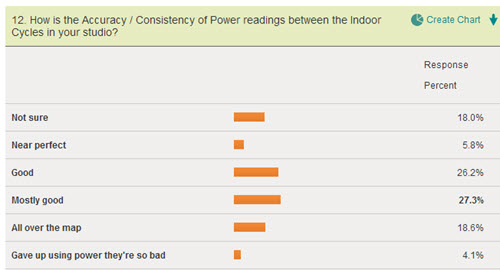
It's a fact of life for all of us teaching power based classes; inconsistency in the watts readings between cycles. Some brands seem to be better than others. Certain bikes seem to be always right, while others are never even close. Calibration is done more frequently by some clubs... or not at all - or the cycles you ride don't offer that option.
This isn't just about us either. Our riders want to feel confident in what they are seeing on their monitors. If they don't believe what they're seeing, they'll soon come to ignore it or worse - ignore you and your coaching.
Here's a screen shot from the Indoor Cycle With Power Instructor Survey - click here to add your experiences.

As you can see, only 32% of Instructors rate their cycles as having Near Perfect or Good Accuracy/Consistency. Those of you in the other 68% have a real challenge, making effective use of the tools we're provided and teaching an awesome class!
So here's what to do about it, three simple steps:
Step # 1 - Acceptance of the problem
I actually found myself getting defensive whenever someone made a negative comment to the effect of; "the power meters on these bike aren't accurate." I'd start making excuses, or questioning the person with; "inconsistent compared to what"? This question, it turns out, does have some value. It's often important for Step #2 to understand; are they are comparing the cycles in your studio to their road bike power meter, or is their complaint focused on inconsistencies between the individual cycles in the room?
If you don't catch yourself, excuses may slip into complaining about management's lack of over-site (not doing regular calibration) or lament that no one asked you which Indoor Cycles to purchase. It you only had XYZ brand this wouldn't be a problem 🙁
This is all out of your control - so just accept "what is", smile and deal with it.
Step #2 - Communicate your acceptance
To your cyclist you may say; "Yes I know that the power you're seeing doesn't compare with the $2,000.00 Quraq power meter on your road bike." "There are a multitude of reasons why you're seeing different watts readings... your fit is different, the crank arms are longer/shorter, etc..." Or you might add; "has it been a while since you were riding consistently?" "Could your fitness have changed"? In any event I feel you just need to communicate your understanding that there is a difference.
More importantly, to your class; these power meters are an awesome tool to help you improve your fitness. We are seeing some variation between cycles, making it difficult to compare wattage numbers between workouts and/or other individual bikes in the room. What's important is today's numbers. After all, yesterday's or last Tuesday's ride is in the past... let's focus on today's effort!
Step #3 - Coach the solution
In the survey we're running, I ask the question; Do you conduct any type of assessment during class, to help your students understand or identify a benchmark watts PTP (Personal Threshold Power)? If so please briefly describe what you do and how you teach it.
Yes I know it was a bit of a "leading question". But identifying a benchmark watts/power # is the solution to inconsistencies between the Indoor Cycle's power meters in your class.
The question was open-ended and drew a number of great responses:
Because the power measurements are so different (inaccurate) among the bikes in the studio I do a 7 minute PPT at the beginning of every class to give each member a usable number for the specific bike they are using.
I need to do a "mini" threshold test at the beginning of every class to get participants "dialed in" because the power readings are so inconsistent from bike to bike.
Yes.. A 5min MAP test
I'm not aware of any "approved" protocol for a benchmark / PTP effort (I call them "Best Efforts"). Depending on your demographic you want these to be 3-7 minutes long - mine are typically four minutes long. I do feel that you and your athletes will benefit from consistency. I do these in every class. If you're a Life Time Fitness Instructor these fit very nicely into the new EDGE Cycling format.
Warm Up — 10 minutes. 5 minutes of gradual increases in wattage. During the second 5 mins. we”™re finding the wattage where everyone is first noticing a change in breathing; VT1 / Aerobic Threshold = the top of the Recover Zone shown above. This establishes a rough understanding of a base wattage that we use throughout the rest of class.
3 x 30 sec. Hard / 30 sec. Easy - Openers to AT/LT. I cue these by first having everyone find the amount of load @ 70 RPM that has them feeling they should (not just could) come out of the saddle. The 30 sec. Hard is then simply accelerating to 90+ RPM which results in some pretty impressive power numbers. The 30 sec. Easy is back to 70 RPM — many will stand during the Easy portion.
2 minutes rest - I encourage riders to focus on their recovery. Once they feel calm in their breathing, bring back the Base level work wattage.
4 min Best Effort - to establish a benchmark PTP Personal Threshold Power (top of the Perform Zone) or ride at 110% of FTP if known. It”™s very helpful to riders to have that understanding of their personal upper wattage number. The “Best Effort” Threshold # + the Base Threshold # we found earlier form the three Power working zones I use in class.
- 1 min. build at preferred cadence (suggested as 85-95 rpm) — press the Stage Button to reset the averages.
- 4 min. “Best Effort” This should hurt, but be do-able. I ask everyone to observe their average at the end
What are your ideas?
Originally posted 2014-01-16 12:46:34.

Have you found one brand of bike is more accurate and consistent over another as far as power?
Pat
John,
A great way to introduce power to the ride without placing too much focus on it. I especially like the 3X30’s. It’s proof positive that without cadence there is no power. Indeed I’ve been using this technique to get my riders with slow legs to understand the value of higher RPM.
What is EDGE? It sounds cycle specific. Does LifeTime fitness only have its instructors deliver cycle specific classes?
Pat I’m still collecting responses so need to wait – it’s heavily skewed to Keiser M3s (which makes sense as they’ve sold the most) so I’m not sure exactly how it will work out.
Chuck EDGE Cycling is LTF’s new branded format. My understanding is that there are multiple reasons beyond LTF wanting to brand a program; more consistency between classes, many will be using their new LT Connect (think Polar/MyZone/Suunto) on-screen HR display – no power and most importantly they are encouraging EDGE Instructors to add more intensity in our classes.
I’m not sure if I’ll get in trouble disclosing more = why I haven’t done a post on it. I’ve invited a few of the leads in the program (Emily Booth / Rob Glick) on the show and hopefully they will get approval to be on in the future to explain more.